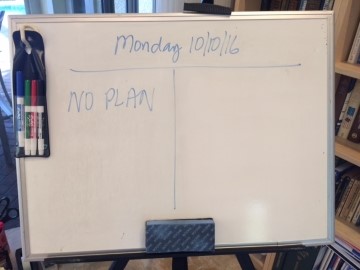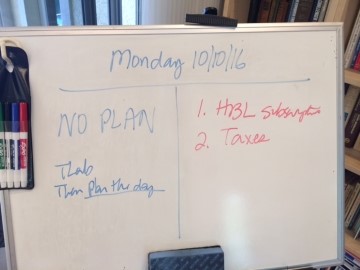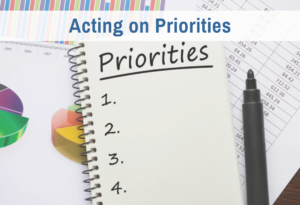In a one-on-one coaching call a few months ago, Roger (not his real name) reported that he was being pulled off course into doing unimportant work. I asked him if he was taking a few minutes to plan the day in the morning.
We had previously discussed how to plan the day in 10 minutes. First you identify the top 3 things you need to finish today. Then you look at your calendar and see how to fit them in. If they don’t fit in, you need to change your expectations or change your plan.
For example, this morning I realized I was tight on time for some urgent work, so I arranged to walk during a phone appointment to squeeze my exercise in, and I postponed a routine check-in with an assistant to a less busy day. I also gave up on getting a particular item done today.
When I asked Roger whether he was planning the day, he became thoughtful. He said he’d found planning the day very useful, but he hadn’t been doing it recently. Why not? Probably because his top priorities were not so clear. Likely, this made planning the day a little off-putting, so he was tempted to jump into clearing email or the like. Once distracted, he never got around to prioritizing and planning.
This is a great example of a difficulty holding context. As soon as we discussed the situation, Roger was convinced that planning the day would solve his problem. He was sure he could figure out his priorities if he tried. He just needed some way to make sure he remembered how important it was to do it. He needed to keep that value context activated.
Here’s a great way to do that: Mark off a part of the whiteboard near your desk for the plan for the day. Put the date at the top, and the plan below. On any day, as soon as you notice that the information is out of date, erase it, write the new date, and “No Plan.” Like this:

Alan Lakein says, “Failing to plan is planning to fail.” If you know how helpful daily planning is, seeing “No Plan” on that whiteboard puts you in instant conflict. It reminds you that you haven’t identified how to achieve your top priorities today.
Roger and I both implemented this idea. Here’s how my plan evolved Monday:


Notice I didn’t plan the day first thing. I prepared a Thinking Lab class instead. I know that when the muse is with me, it’s better to do concentrated thinking. If I look at my to-do list too early, I destroy the creative process.
Jumping into creative work sometimes led me to forget to plan my day. Now that my whiteboard says “No Plan,” it doesn’t.
As an aside, notice that on this day, my initial beliefs about my priorities were all wrong. When I took 10 minutes to plan the day, I figured out what they really were.
If you don’t plan the day as often as you wish, I highly recommend this strategy. You can buy a little 8×10″ whiteboard to prop up on your desk. It will give you a visual reminder of how important it is to plan your day.
The key that makes the whole thing work? When first you see it’s out of date, erase yesterday’s material, write today’s date, and admit you have no plan.








0 Comments